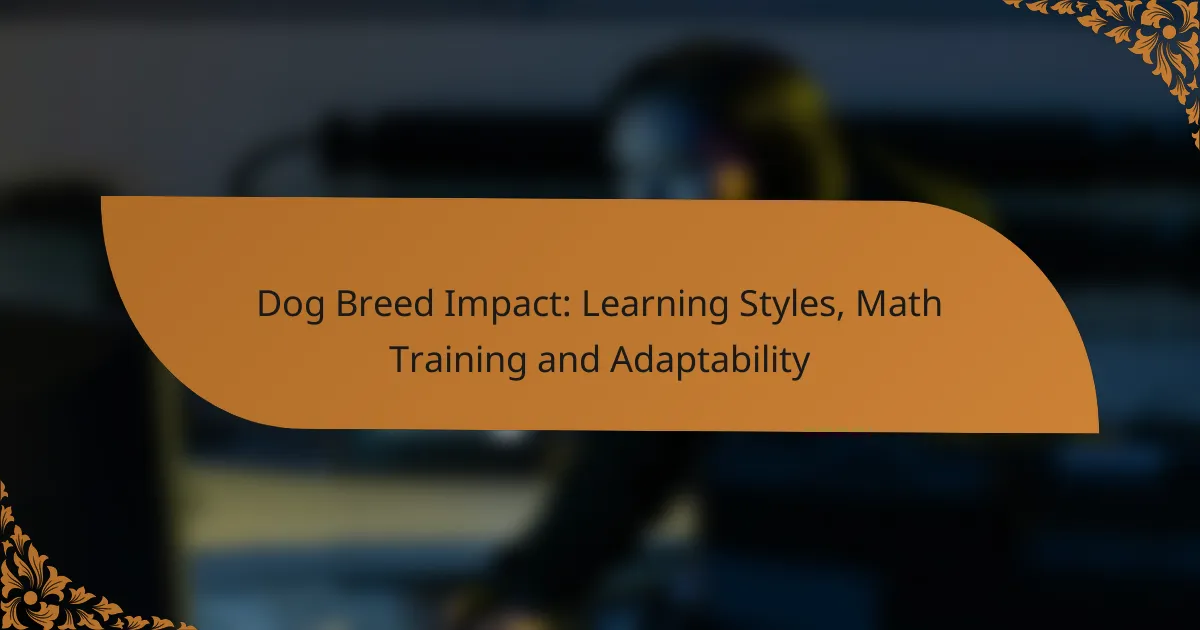Understanding the impact of dog breeds on learning styles is crucial for effective training and adaptability. Each breed has unique traits that influence how they respond to various training methods, including math training techniques that utilize positive reinforcement. By recognizing these differences, owners can better tailor their approaches to enhance their dogs’ learning experiences and overall adaptability in diverse environments.

How do dog breeds influence learning styles?
Dog breeds significantly impact their learning styles, affecting how they respond to training and adapt to various tasks. Understanding these influences can help owners tailor their training approaches to suit their dog’s innate abilities and instincts.
Breeds with high intelligence
Breeds known for high intelligence, such as Border Collies and Poodles, tend to learn commands quickly and excel in obedience training. These dogs often require mental stimulation and thrive on challenges, making them ideal candidates for advanced training techniques.
When training intelligent breeds, focus on positive reinforcement methods to keep them engaged. Regularly introducing new tricks or tasks can help maintain their interest and prevent boredom.
Breeds with strong instincts
Some breeds, like German Shepherds and Labrador Retrievers, possess strong instincts that guide their learning. These dogs often excel in specific roles, such as service or working dogs, due to their natural abilities and drive to please their handlers.
Training these breeds should leverage their instincts, incorporating activities that align with their natural behaviors. For example, using scent work for retrievers can enhance their learning experience and effectiveness in tasks.
Breeds suited for specific tasks
Certain breeds are specifically developed for tasks, such as herding, hunting, or guarding. Breeds like Australian Shepherds are excellent herders, while Beagles are renowned for their tracking abilities. Understanding a breed’s purpose can inform training methods and expectations.
To optimize training for task-oriented breeds, ensure that the training environment mimics real-life scenarios they would encounter in their roles. This approach can enhance their learning and adaptability to various situations.
Examples of adaptable breeds
Adaptable breeds, such as the mixed-breed dog or the Labrador Retriever, can thrive in diverse environments and training situations. Their versatility allows them to learn a wide range of commands and tasks, making them suitable for various roles, from family pets to working dogs.
When working with adaptable breeds, emphasize socialization and exposure to different environments. This practice helps them become well-rounded and responsive to various training methods, enhancing their overall learning experience.

What are effective math training techniques for dogs?
Effective math training techniques for dogs involve using methods that engage their learning styles and promote understanding through positive reinforcement. Techniques such as clicker training and incorporating toys can enhance their ability to grasp basic mathematical concepts.
Positive reinforcement methods
Positive reinforcement methods focus on rewarding desired behaviors to encourage learning. When training dogs in math tasks, use treats, praise, or playtime as incentives for correct responses. This approach not only builds a positive association with learning but also increases motivation.
Start with simple tasks, such as recognizing numbers or performing basic addition by associating a specific action with a reward. Gradually increase the complexity as your dog becomes more comfortable with the concepts, ensuring that rewards are consistent and immediate.
Clicker training for math tasks
Clicker training is a popular method that uses a distinct sound to mark desired behaviors, making it effective for teaching math tasks. The clicker serves as a clear signal that the dog has performed correctly, followed by a reward. This technique helps dogs understand the connection between their actions and the outcomes.
To implement clicker training, start by teaching your dog to associate the click sound with a treat. Once they grasp this association, introduce simple math tasks, such as counting treats or identifying shapes, and click when they respond correctly. Consistency is key, so practice regularly to reinforce learning.
Using toys as learning tools
Using toys as learning tools can make math training more engaging for dogs. Interactive toys that require problem-solving can help dogs develop their cognitive skills while learning basic math concepts. For instance, toys that dispense treats based on the dog’s actions can illustrate cause and effect.
Choose toys that challenge your dog without causing frustration. For example, puzzle toys that require the dog to figure out how to access treats can be linked to counting or sorting tasks. Incorporate these toys into training sessions to keep your dog interested and motivated to learn.

How adaptable are different dog breeds?
Different dog breeds exhibit varying levels of adaptability, which refers to their ability to adjust to new environments, situations, and training methods. Breeds that are more adaptable tend to thrive in diverse settings, making them suitable for various lifestyles and family dynamics.
Factors affecting adaptability
Several factors influence a dog’s adaptability, including genetics, early socialization, and training experiences. Breeds with a history of working closely with humans, such as herding or service dogs, often show higher adaptability due to their exposure to different environments and tasks.
Additionally, individual temperament plays a crucial role. Dogs that are naturally curious and confident are typically more adaptable than those that are shy or anxious. Consistent training and positive reinforcement can further enhance a dog’s ability to adjust to new situations.
Examples of highly adaptable breeds
Some dog breeds are renowned for their adaptability, including the Labrador Retriever, Golden Retriever, and Poodle. These breeds are known for their friendly nature and eagerness to please, making them well-suited for various living conditions and family structures.
Mixed breeds often display high adaptability as well, benefiting from diverse genetic backgrounds that may contribute to their flexibility in different environments. Ultimately, the individual dog’s personality will also significantly impact its adaptability, regardless of breed.
Training methods that enhance adaptability
Positive reinforcement training is one of the most effective methods for enhancing a dog’s adaptability. This approach encourages dogs to learn new behaviors and adjust to changes in their environment through rewards, fostering a sense of security and confidence.
Socialization is another critical aspect. Exposing dogs to various people, animals, and environments from a young age helps them develop the skills needed to adapt to new situations. Regular training sessions that introduce novel challenges can also improve a dog’s adaptability over time.

What role does environment play in dog training?
The environment significantly influences dog training by shaping behavior, learning styles, and adaptability. Factors such as urban or rural settings, socialization opportunities, and access to training facilities all contribute to how effectively a dog can learn commands and skills.
Impact of urban vs rural settings
Urban environments often present more distractions, such as noise and crowds, which can challenge a dog’s focus during training. However, these settings also provide diverse socialization experiences with various people and animals, enhancing adaptability.
In contrast, rural settings typically offer more space and fewer distractions, allowing for focused training sessions. The downside may include limited exposure to different stimuli, which can affect a dog’s social skills and adaptability in varied environments.
Socialization opportunities
Socialization is crucial for a dog’s development and can vary greatly depending on the environment. Urban dogs often encounter a wide range of people, pets, and situations, which can help them become well-rounded and confident.
Rural dogs may have fewer socialization opportunities, making it essential for owners to actively seek out interactions with other dogs and people. Regular visits to dog parks or organized playdates can help bridge this gap.
Training facilities in major cities
Major cities typically offer a variety of training facilities, including obedience schools, agility courses, and specialized training programs. These facilities often employ experienced trainers who can cater to different learning styles and needs.
In contrast, rural areas may have limited access to such resources, which can hinder a dog’s training progress. Owners in these regions might consider online training courses or traveling to nearby towns for classes to ensure their dogs receive quality training.

How can dog owners assess their dog’s learning style?
Dog owners can assess their dog’s learning style by observing their behavior, experimenting with different training methods, and seeking guidance from professional trainers. Understanding how a dog learns can enhance training effectiveness and strengthen the owner-pet bond.
Observation of behavior
Observing a dog’s behavior during training sessions is crucial for identifying their learning style. Take note of how your dog responds to commands, rewards, and different training environments. For instance, some dogs may thrive on verbal praise, while others may respond better to treats or playtime.
Look for patterns in their reactions. Does your dog seem more engaged when learning through play, or do they prefer structured commands? These insights can guide you in tailoring your training approach to suit their unique preferences.
Trial and error in training
Trial and error is an effective method for discovering your dog’s learning style. Experiment with various training techniques, such as clicker training, positive reinforcement, or even agility exercises. Monitor your dog’s responses to these methods to determine which ones yield the best results.
Keep in mind that patience is key. Some dogs may take longer to adapt to new techniques, so give each method a fair chance before moving on. Documenting your observations can help you track progress and refine your approach over time.
Consulting with professional trainers
Consulting with professional trainers can provide valuable insights into your dog’s learning style. Trainers often have experience with various breeds and can offer tailored advice based on your dog’s behavior and needs. They can also introduce you to effective training techniques that you may not have considered.
When choosing a trainer, look for someone who uses positive reinforcement methods and has a good reputation in your area. Many trainers offer initial consultations, which can help you gauge their approach and determine if it aligns with your training goals.

What are the best practices for training adaptable dogs?
Training adaptable dogs effectively involves using positive reinforcement techniques, consistency, and understanding their unique learning styles. Tailoring your approach to their specific needs can enhance their ability to learn and adapt to various situations.
Understanding Learning Styles
Each dog has a unique learning style that can influence how they respond to training. Some dogs may learn best through visual cues, while others might respond better to verbal commands or hands-on guidance. Observing your dog’s reactions can help you identify their preferred learning method.
To cater to different learning styles, consider using a mix of training techniques. For instance, pairing verbal commands with hand signals can benefit dogs that are both auditory and visual learners. Regularly assess your dog’s progress and adjust your methods as needed.
Incorporating Math Training
Math training for dogs involves teaching them to recognize patterns and solve simple problems, which can enhance their cognitive abilities. This type of training can be introduced through games that require counting or recognizing shapes, fostering mental stimulation.
Start with simple tasks, such as using treats to teach your dog to associate numbers with quantities. Gradually increase the complexity of the tasks as your dog becomes more comfortable. Keep sessions short and engaging to maintain their interest.
Promoting Adaptability
To promote adaptability in dogs, expose them to various environments, people, and situations. Gradual exposure helps them become more comfortable with change and reduces anxiety in new settings. Socialization is crucial during the early stages of a dog’s life.
Incorporate training sessions in different locations and introduce your dog to new experiences regularly. This could include visits to parks, pet-friendly stores, or even different neighborhoods. Always ensure these experiences are positive to build your dog’s confidence.
